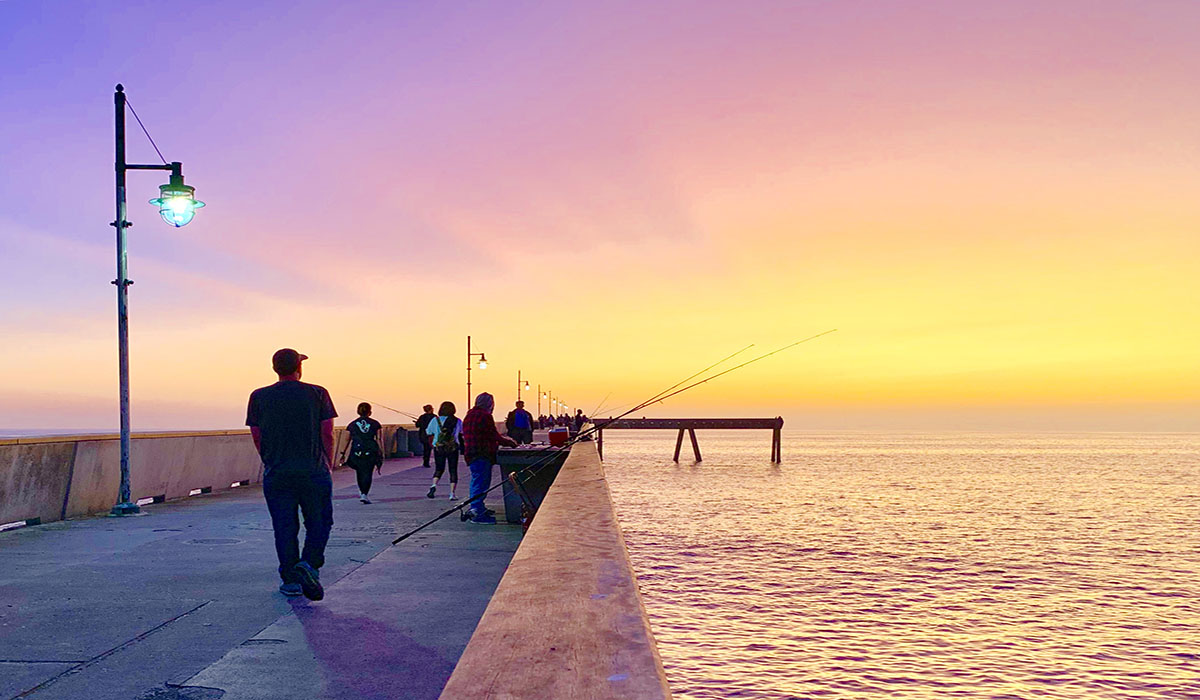
Public Pier – No Fishing License Required –
Originally written, October 2021 by Ken Jones – Above photo by Mark Hubbell
The question of what is the best pier in the state is one that I have been asked fairly frequently over the years. Given that the answer depends on a number of factors (including the personal affection which anglers have for their own piers), I always hesitate to give an answer. However, when the first edition of Pier Fishing In California was published (in 1992) I named this pier the number one pier in the state. Why? The answer was that no other pier in the state yielded the number of fish, nor the quality of fish, that was seen at the Pacifica Pier (aka the Rev. Herschel Harkins Memorial Pier).
My answer though was nuanced. There were the headlines and there were my own personal experiences, records and opinions. I had begun to fish the pier starting in September 1975 and quickly discovered that it yielded a high number of fish and a nice variety of fish. By the late 1970’s I had already judged it one of the best piers in the state even though I had rarely seen a salmon taken from the pier.
But the salmon did show up and the number of salmon taken, together with the number of fishermen responding to the salmon, is what made the pier famous (or infamous depending upon your viewpoint).
The salmon, mostly king salmon, began to show up in the early ‘80s and reached a crescendo-shattering peak in 1995. When the salmon were running the pier was filled with anglers hell bent on catching one of the good-sized, good fighting, and good eating fish. In ‘95 the anglers would be joined by reporters and cameramen sent to film the frenzied scene. Almost all of the Bay Area television stations, and newspapers in and outside the state, had stories about the salmon being caught at the Pacifica Pier. Accompanying pictures showed large salmon being hauled onto the pier and anglers lined up elbow-to-elbow along the railing. In addition, some less-than-accurate articles appeared in fishing magazines.
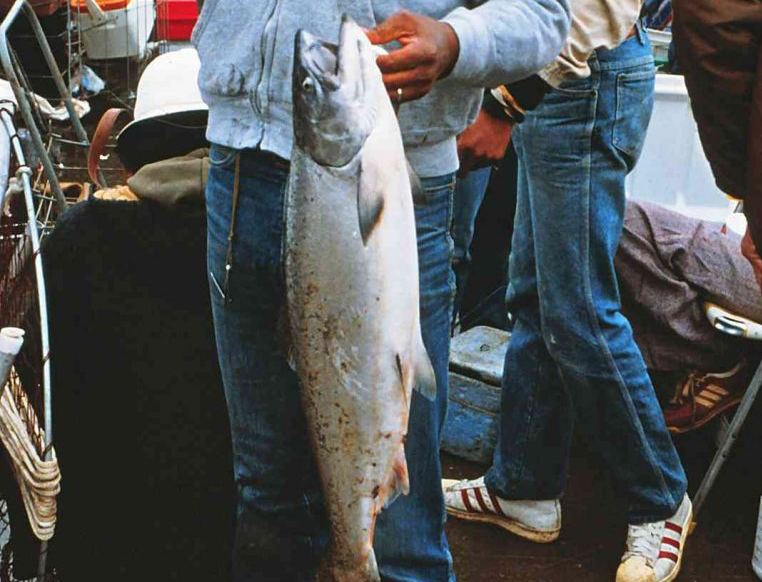
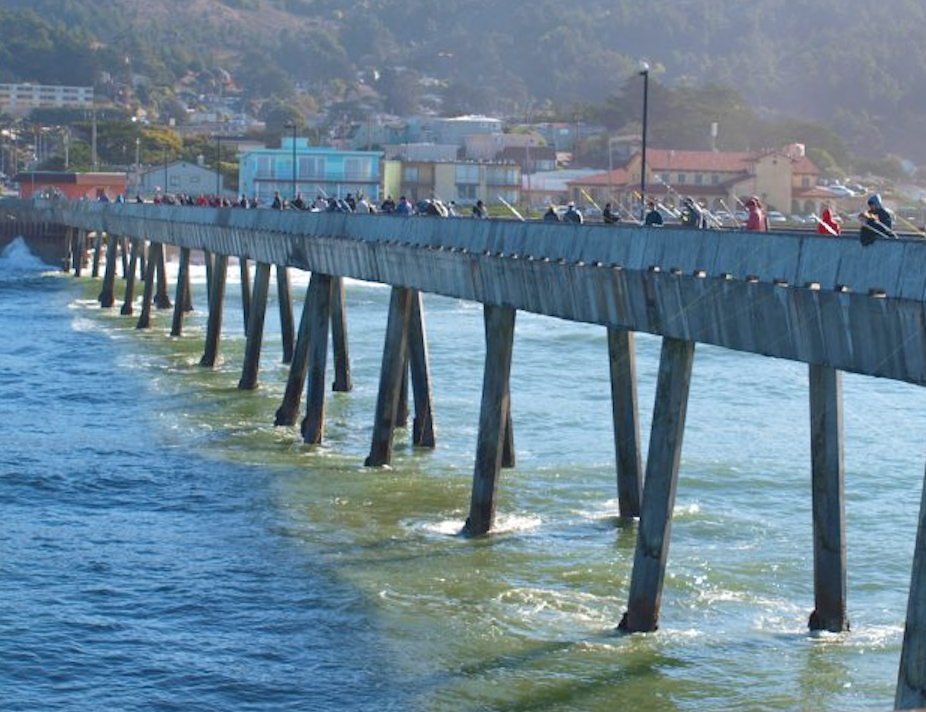
A natural result of all this publicity was that more and more anglers flocked to the pier and it became even more crowded (especially in the coveted spot at the end—“Little Manila”). The crowding caused new problems including tangled lines, shortened tempers, occasional arguments, and a general thrashing of the pier. Although the pier had become famous for the salmon, many viewed the pier as a place to be avoided because of the crowds and the other problems experienced at the pier (one critic noting “garbage everywhere” and the “sickening smell of urine along the further reaches and L of the pier”). Most agreed the pier was a zoo during the prime salmon season and many saw little piscatorial pleasure in such surroundings. Eventually, one angler gave it a new name — Pathetica Pier.
There were alternative views. One angler said, “All the negative aspects seem insignificant when anglers start to pull up salmon and stripers.” Another PFIC regular, thecrw, said, “I pose this rhetorical question: Is it Fanatical Fishing or a Hard Earned Fish? At first glance, the crowded pier and tangle lines may put many of us off from fishing for salmon at Pacifica. But, like banging around in a Mosh Pit, it could be fun for a select few. Dealing with tangled lines, sideways running fish and, then trying to net it while a fur bag tries to steal it makes for an exciting story. I haven’t participated in this mayhem, but hope to, just to say I was there.” The arguments raged on—as did the publicity.
Unfortunately, the picture presented by the media was a little misleading, at least if you are trying to tell the full story of a pier. But that was never the intent. If you’re going to make the evening news you need an exciting story — you need something to grab the viewer’s attention! A crowded pier filled with anglers jostling for space (or lamenting a lack of space), animated fishermen fighting fish, onlookers yelling advice in a half dozen languages, bloody trophy fish being hauled up to the pier, and crowds gawking in appreciation and jealousy presented that excitement. There was always an eager angler willing to show his or her fish and to present his or her story. Coming up on the 11 o’clock news—big crowds and big fish at Pacifica! It definitely was an exciting time at the pier.
King Salmon
Lost amidst the excitement were the quiet times when the crowds were gone but fishing remained good. But pictures of a nearly empty pier are not going to grab attention—or help the ratings.
But it was those quiet times that had early on convinced me that the pier was one of the best in the state. My visits during the pre-salmon, less crowded years, produced an average of more than 23.2 fish per trip and 6.33 fish per hour, both among the best averages for me on any pier in California (at that time).
Visits also showed an excellent variety. As an example, a day in June of 1977 saw eleven different species (redtail surfperch, walleye surfperch, silver surfperch, spotfin surfperch, white seaperch, shinerperch, starry flounder, sand sole, Pacific tomcod, white croaker, and staghorn sculpin). A January day in the same year saw ten different species (redtail surfperch, calico surfperch, barred surfperch, walleye surfperch, silver surfperch, shinerperch, Pacific sanddab, white croaker, jacksmelt, and staghorn sculpin). Most of my trips to the pier have included at least six or more different species.
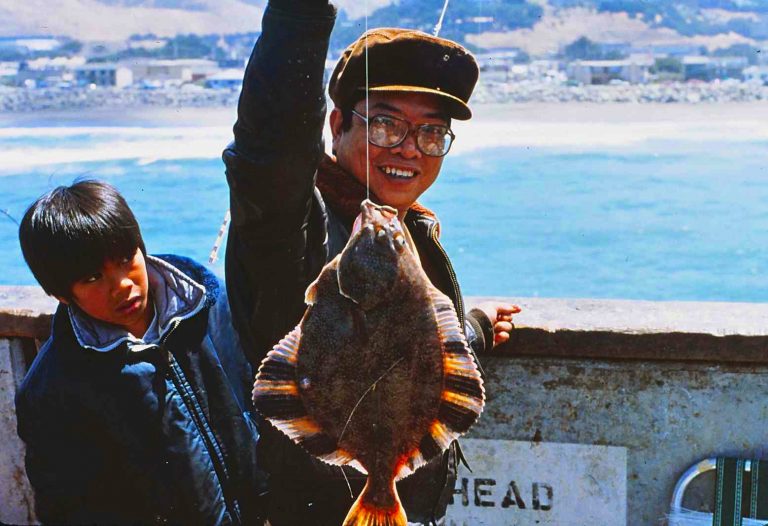
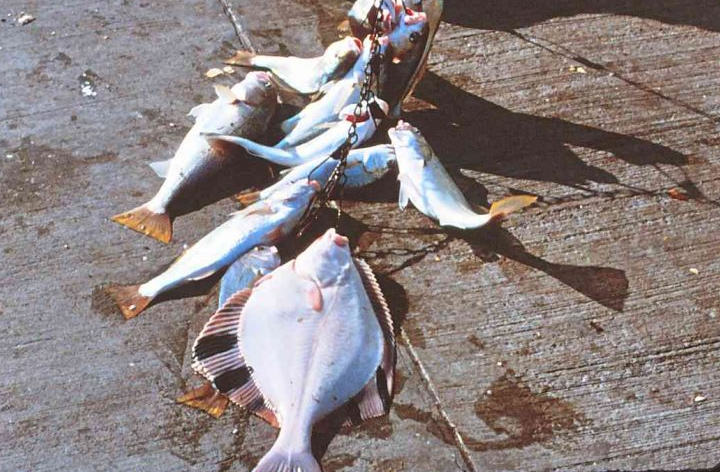
In addition, I caught fish year round, not just during the main June-August salmon months. In fact, one of the best times to fish the pier was in the winter. As an example, 1978 saw me visit the pier five times during February and March. I totaled 198 fish in those five trips. Included in the mix were 14 large redtail surfperch, 12 large barred surfperch, 3 large calico surfperch, 43 walleye surfperch, 106 silver surfperch, a 38-inch leopard shark, and a plethora of other species including Pacific tomcod and jacksmelt.
Given those numbers, what was most interesting was that the pier was virtually deserted, almost empty of people because fishing was “so slow.” Wintertime trips would also often yield Pacific sanddab; one chilly, early-morning trip in January yielded 35 sanddab out of a 60-fish catch.
This second story, not of salmon or crowds, but of excellent fishing for small and medium-sized pan fish together with moderate crowds, was, in my mind, at least as important as the first. But a news story that is balanced, thorough, or devoid of sensationalism was as rare in those days as it is today.
Unfortunately, those early results, both for the smaller pan fish and the larger salmon, are rarely duplicated today. There are still occasional runs of smaller fish—surfperch, jacksmelt or baitfish such as sardines, and occasional runs of salmon, but day in and day out it’s become a very average pier. In fact, the number one activity at the pier, at least during the months of November-June is now the pursuit of crabs, namely Dungeness crabs.
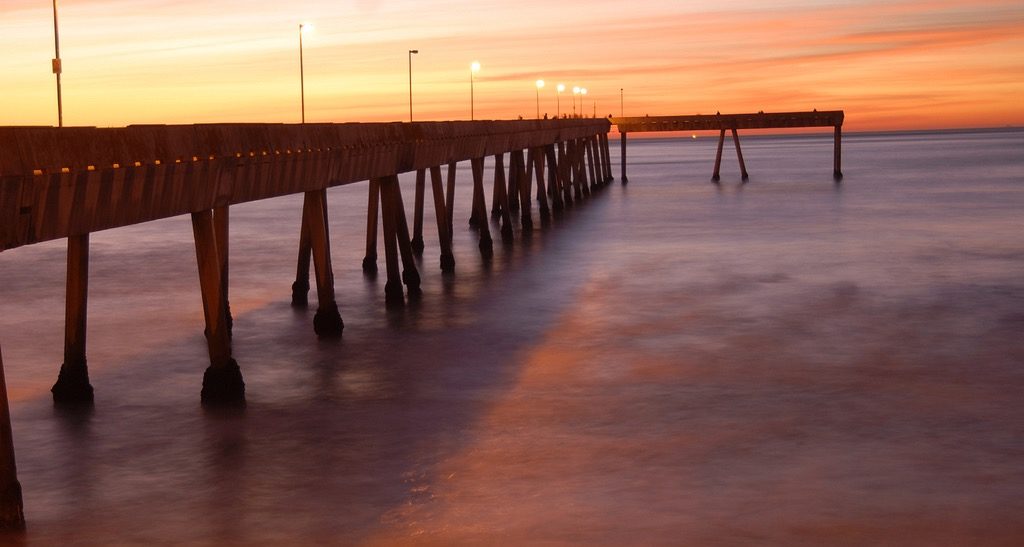
Environment – Above photo by Glen Hogerton
The L-shaped pier, most commonly called the Pacifica Pier or Sharp Park Pier, is officially titled the Rev. Herschell Harkins Memorial Pier. But, it also at times has earned the somewhat derisive nickname “Elbow-to-Elbow Pier.” It’s a sobriquet richly earned during the salmon runs when the salmon are fighting over the bait and anglers are fighting over space at the railings.
The pier is 1,140-foot-long, 19-1/2 feet wide for most of its length, and 138 feet wide at the end. It’s an all-concrete pier that fronts directly on Sharp Park State Beach and both the beach and pier can see strong winds and huge, huge punishing waves.
The bottom around the pier is primarily sand while the hexagonal pilings are heavily encrusted with invertebrates—California mussels, stalked barnacles, and ochre sea stars. A mélange, which, in turn, is home to small crabs, shrimp and, other fish-attracting critters. The sand is home to mainly sandy-shore species while the pilings rarely fail to attract fish looking for food.
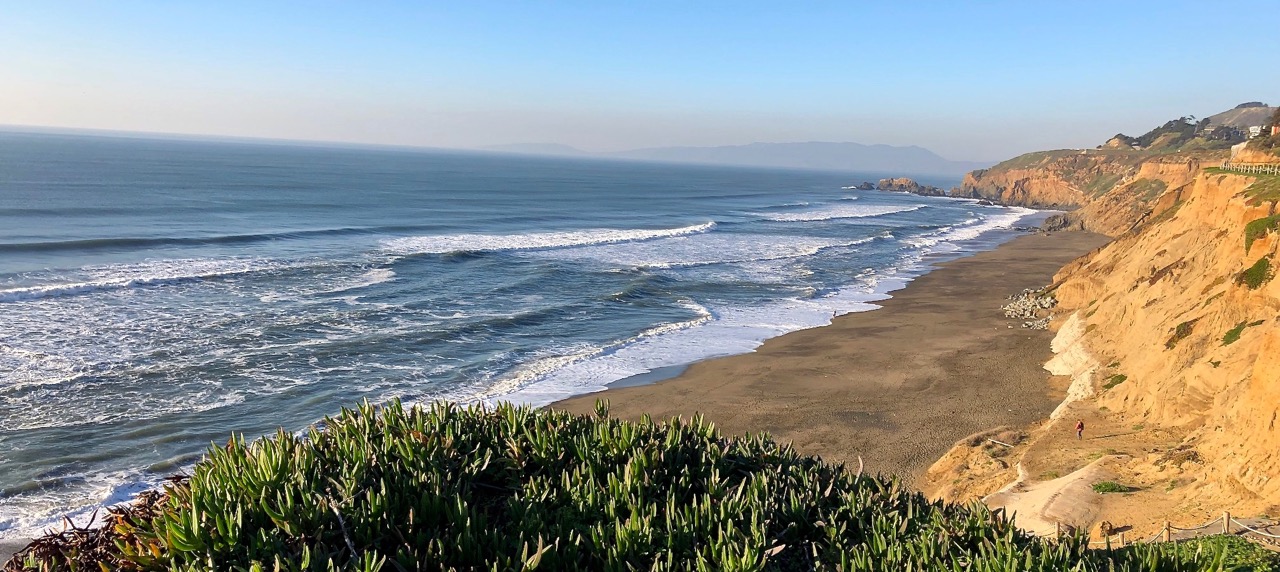
Looking north you see a sandy shoreline (incorporating several different beaches) that runs for miles. The beaches were once famous for striped bass. Western striped bass anglers would come, year after year, to confront some of the largest stripers in America. Unfortunately, the glory years seem, for the most part, a thing of the past. Although there are still some exceptional seasons (like 1995) most years see far fewer fish, especially the large 30+ pound fish once taken on a regular basis. Nevertheless, regulars with the proper knowledge and technique still rack up some pretty impressive fish. Above and bottom photos by Carol Camacho
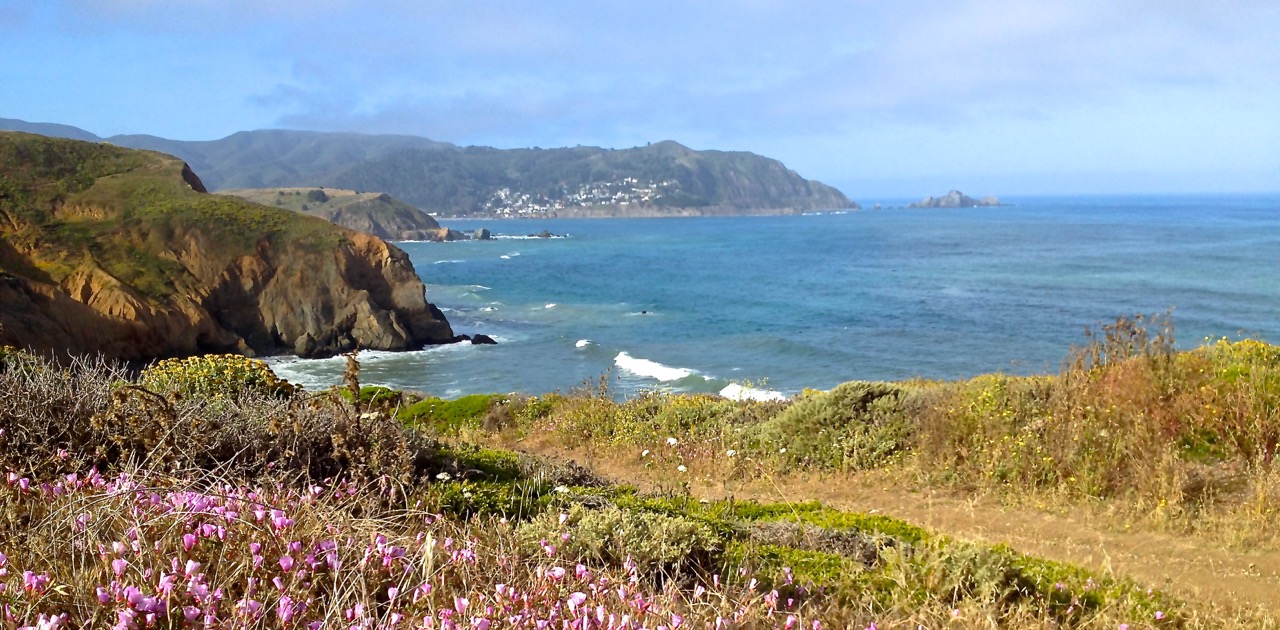
Looking southward you’ll spot Mori Point, a great fishing spot on its own, and Rockaway Beach. A little further down the coast sees San Pedro Beach and picturesque San Pedro Point, another fishing spot of note.
The wind can often make the pier uncomfortable, while fog and drippy dew can be a constant companion during the summer months. Pier-shaking waves, that sometimes break over the pier and drench the pier, can lead to closures. But sometimes the sun makes a visit and the coastline presents itself in all its glory. When the whales, dolphins and seabirds make an appearance, the fish cooperate, and the pier isn’t too crowded, you can almost imagine you’re in paradise.
The Fish
The pier shows a good, if not, an exceptional variety of species at the pier. Fish counts done by the California Department of Fish and Game for the years 2004-2009 show a mix of 27 species of fish at the pier which is about the same number of species that I have caught at the pier (although I’ve caught some different species). If the number of different species reported by the PFIC fraternity were included, the number of species at the pier would exceed 40.
Perch—As an avid perch fisherman, one who has sometimes been called “The Perch Master,” they of course have a special place in my heart. Luckily, I always considered the pier’s perch fishery to not only be among the best in the state but also unique. It is one of the few places where an angler can see an overlap in California’s three “big” surfperch species: barred surfperch from the south, the calico surfperch of central California, and the redtail surfperch of northern waters. Many times I have had the pleasure of hitting a “trifecta” on these fish, the only pier where I have seen this happen. Surprisingly, the redtail surfperch lead the list of those fish followed by barred and calico surfperch.
The smaller surfperch though were always the bread and butter fish with very high numbers of silver and walleye surfperch followed by high numbers of spotfin surfperch. Shinerperch were also numerous but virtually every California perch species was seen—pileperch, whiteperch, sharpnose perch, blackperch striped perch, rainbow perch and even a few rubberlip perch. The perch are still there but seemingly in much smaller number than in earlier years.
Miscellaneous Bottom Fish — Several small, bottom-dwelling species are found in the waters out from the pier. By far, the number one fish numerically is kingfish (white croaker), a fish that is much maligned throughout the state. In many areas it’s considered inedible since the flesh may contain toxins caused by their feeding habits. The small croaker like nothing better than feeding on the small organisms that live on the bottom, organisms such as seaworms and clams, that themselves contain toxins from living in toxin-infused areas. Most of the concern is from urban areas and bays (like San Francisco bay) where benthic (bottom) areas are often saturated with toxins. The white croakers at Pacifica are, as far as I know, much safer to eat. Of course the fact that they may grab bait intended for more prized fish or the fact that they are feeble fighters at best, are separate questions.
A closely related SoCal croaker species, fairly rare to this northern area, is the queenfish and two have been reported to PFIC, one in 2017 and one in August 2021.
A second fish is Pacific tomcod, a fish that seems to be rarely identified correctly. Due to its size it is an easily overlooked fish but Pacifica is one of the few piers in California where they have been caught. There is a question as to if their numbers have decreased or if few are reported due to this incorrect identification.
Far too common are the bait-stealing staghorn sculpin (bullhead), which are much despised (but which also make good striper bait). No one admits to liking the small sculpins although I’ve had a few people tell me they are actually tasty.
Surprisingly, a few rocky-shore species also show up at this mostly sandy-bottom pier. Many lingcod have been landed (including a 28-incher in August 2006) as well as large and small cabezon (to over 20 inches). Kelp greenling included a 14-inch fish caught by PFIC member West Coast Dave in March 2005. Rockfish will also make an occasional appearance, most often a grass or brown rockfish although small, juvenile bocaccio sometimes enter into the mix. None of these are common but a few will be landed each year, generally down at the base of the pilings where the mussels act as attractants.
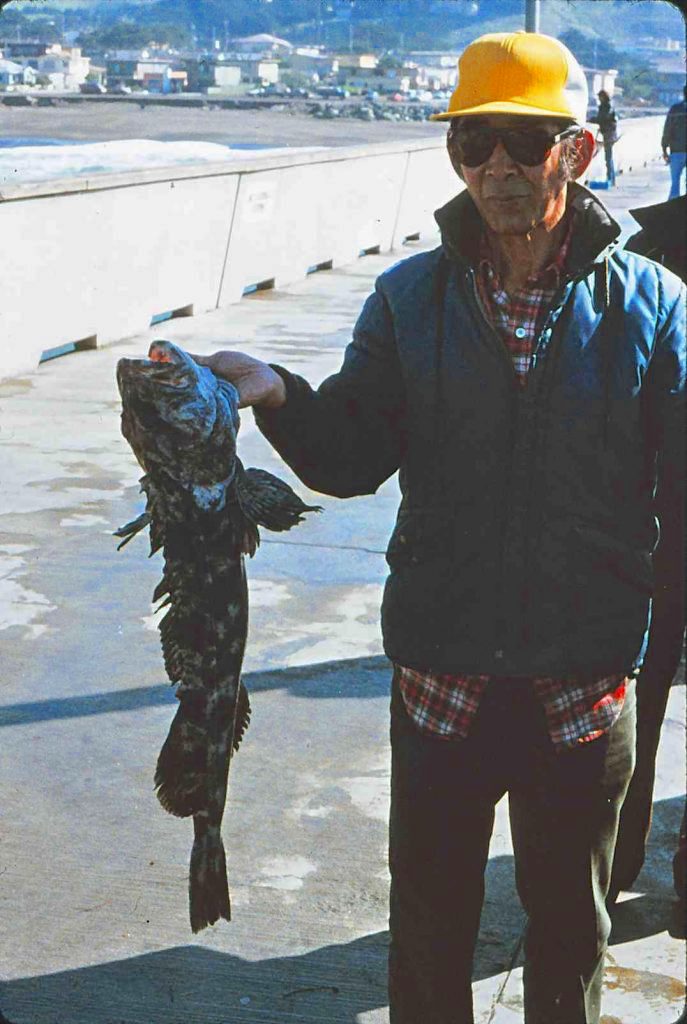
Lingcod
Mid-water and Top-water Schooling Species — Jacksmelt and topsmelt are common throughout the year. Top-water baitfish come and go with Pacific sardines and northern anchovies most common. Occasionally schools of Pacific herring make a showing (generally in winter or spring while occasionally Pacific butterfish (pompano) are also seen.
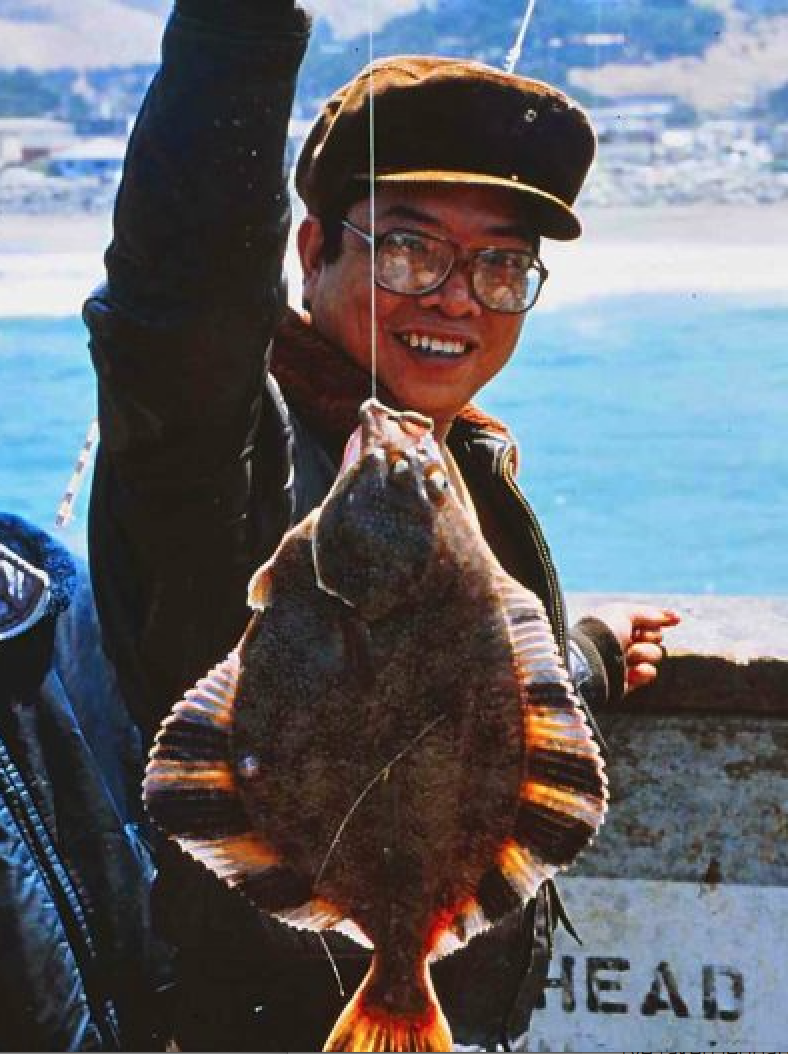
Starry Flounder
Flatfish — Flatfish include good numbers of Pacific sanddab (generally during the winter months), quite a few sand sole (Pacifica is one of the best piers in the state for these), and an occasional starry flounder. Anglers who make the effort, proper rigs and live bait, may also encounter an occasional California halibut during the May through September season.
Sharks and Rays — As for sharays, the sharks and rays, occasional fish are taken but rarely in large numbers considering the plethora of anglers who fish the pier. To be fair though, few anglers seem to specifically target the sharks, most are too busy fishing for striped bass and salmon. Leopard sharks probably lead the hit parade of sharks followed by brown smoothhound sharks and an occasional thresher shark.
I’ve taken leopard sharks and brown smoothhounds but seen few of the larger sharks. Dogfish to 40-inches have been reported at times while PFIC regular Red Fish took a 45” soupfin shark in 2017. Thresher sharks do seem to show up most years, usually during the summer if the salmon are around, and a few will be taken (including a 10-foot-long thresher in August of 2010). It’s not clear if they are chasing salmon or the same baitfish the salmon are chasing but they generally appear about the same time. Some anglers do fish for the longtails but the numbers rarely justify targeting them specifically.
Bat rays (aka mud marlin) are also encountered, including some of the big old mama rays, but again the numbers rarely justify an expedition specifically for the rays. If you want mud marlin head to piers inside San Francisco Bay.
Skate too, show up. Most will be big skates and they do reach a big size. One estimated to weigh at least 80 pounds was caught in 2006.
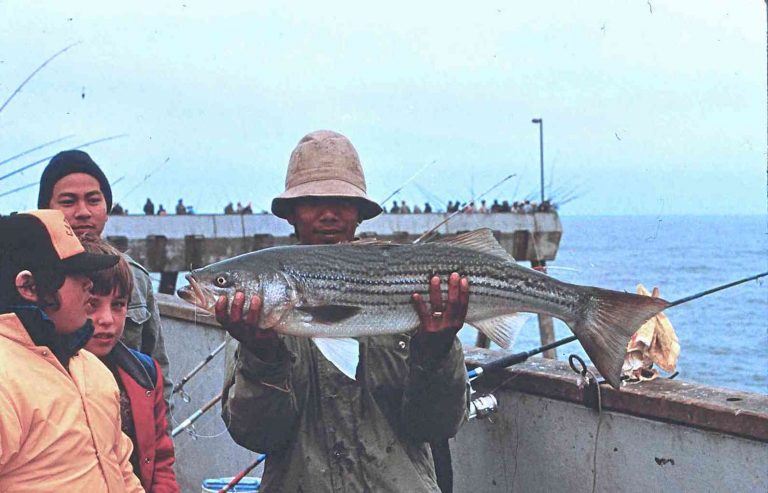
Striped Bass
Striped bass are one of the prized fish at the pier and though they sometimes get overshadowed by salmon when a “run” is on, the stripers are far more reliable showing up virtually every year between the spring and fall months (when they head into the Bay). Included, most years will be some nice–sized fish. Reports to the PFIC Message Board reported many stripers to 30 pounds (July 1998), many stripers (July 1999), many stripers to 30 and 40 pounds (July/August 2003), many stripers to 36 pounds (July 2005).
Salmon
Pacifica became famous in the ‘90s as the state’s number one producer of pier-caught salmon. During one weekend alone, July 8-9, 1995, over a thousand salmon were landed on the pier. In fact, July 8 may have seen as many as 1,000 salmon landed on that single day. After a while, most people gave up on trying to keep an accurate count of the fish (although regulars tend to agree that it was over 800 fish). So many fish were landed in fact that the Fish and Game deputies finally came out to the pier to check on the action. Most notable was the citation to one angler who had caught 17 salmon all by his lonesome self, a figure that is (if my math is correct) about 850% of the 2-fish limit.
I argued one day that Pacifica had seen a decline and it just didn’t see as many salmon any longer. Not all anglers agreed. Longtime PFIC regular Calrat replied (May 8, 2007): “I often contact regulars at Pacifica that also fish other areas with me and they have had phenomenal salmon takes every year thus far. People say that the Pacifica salmon take is down only because a small percentage of people still catch them. Sure, they’re not seeing half the pier take off with numbers anymore but the guys who have been out there over a vast number of years (like the Filipino Mafia) are still going out there landing a great many.”
In response, I decided to check the PFIC Message Board. It showed he was right—to some extent. July 11, 1998—over 200 salmon taken to 25 pounds. July/August 1999—many salmon taken on most days. August 2001—many salmon with some days seeing as many as 40 landed including fish over 30 pounds. July 2002—a lot of salmon showing up. July 2003—salmon to 29 pounds have arrived. June 2004—Many salmon limits being taken of salmon but most are under 20 pounds; on June 30 over a hundred salmon landed. July 2004—the pier is packed; saw over 50 salmon landed and people were leaving with limits by 11’ish. A lot of baitfish in the water—sardines, anchovies and shiners. One later reports said one day saw 300 salmon were caught in one day. No year has matched or surpassed those 1995 numbers but some years did still see some pretty good numbers of salmon.
For many reasons, this is (or was) a fish-rich area of water, although few years see the type of results witnessed in 1995. The coastal upwelling that year produced tremendous blooms of plankton that then attracted huge schools of anchovies and sardines to the area. The small baitfish were followed by the larger salmon, striped bass, and California halibut. It was an unprecedented spectacle and Pacifica was, for a period of time, probably the only pier that offered an angler the possibility of a Bay Area “Grand Slam”—a king salmon, striped bass, and California halibut all on one day (even if a remote possibility).
Rare today is the angling seen in the ‘90s but some years do see conditions that seem ripe for good fishing (and the answer is usually bait in the water, bait usually attracted by plankton). A report by Danthefisherman on October 11, 2006, a period of good fishing for mackerel said: “Miles and miles of bait. People were filling their buckets with anchovies… five at a time. The anchovies went on as far as you could see. There were a few whales hanging out on the horizon as well, probably cashing in on the bait. As the sun was setting, there was so much bait jumping, it looked like it was raining. They were average size, but there were a few waves of 8-9” ‘chovies. The word on the pier is that the mackerel come in after the anchovies.”
Anomalies
Sometimes uncommon or rare fish show up at a pier and sometimes there isn’t any appreciable reason. Sometimes there is a change in water temperature is most often the cause. El Niño years that see warm-water being pushed north along the coast is a primary factor for fish migration. The warm waters often bring more southerly SoCal and Mexican species with them. The La Niña, cold–water years seem to have far less impact but may bring a few more northerly species south. Of course the water temperature also ties in with bait fish, aka food for the larger fish, that also respond to the different water temperatures. Fish go where there is food and if bait fish (food) moves north or south many of the larger fish will follow.
When the warm El Niño waters reach the Bay Area it’s almost inevitable that a few of the more southerly fish will be caught at Pacifica. As such, the fish are anomalies and not something an angler should plan to catch.
An example is white seabass, (actually a large croaker), that for most of the late 20thcentury (1960-2000) was considered an uncommon, almost rare catch in San Francisco Bay. It’s an interesting statistic because there was a time when white seabass spawned in Tomales Bay every year and were caught annually by both sport and commercial fishermen. They declined due in large part to the gill nets employed by commercial fishermen but appear to be making a comeback. Luckily, they are still common in Monterey Bay (so not too far south).
The most notable white seabass at the pier was a 41 1/4-pound fish taken in 1992, a strong El Niño year. July 2003, a very strong El Niño year, saw a white seabass taken on a live sardine. In Mid-July 2005 another white seabass was reported; the only one reported in a La Niña, cold–water year. In 2009, a moderate El Niño year saw several more of the tasty fish landed including a mid-summer fish estimated to weigh 40 pounds. In the summer of 2015, one more strong El Niño year, a white seabass was taken from the end of the pier that guesstimates put around the 30-pound mark. A large though not weighed white seabass was taken in July of 2021. Thus not a lot of white seabass but the ones that were landed were generally good size.
Barracuda are a species rarely seen this far north. Nevertheless barracuda were reported from the pier in 1992, a strong El Niño year. Barracuda showed up again in August of ’99 and September of 2001 when a 39-inch barracuda was reported from the pier. Surprisingly, the latter two years were not El Niño years (in fact 1999 was considered a strong.La Niña or cold-water year.
Some years will also see Pacific mackerel make an appearance. Reports in August and September of 2006 saw “mackerel everywhere along the pier” and told anglers to bring their Sabiki rigs. 2009, a moderate El Niño year, saw another big run of mackerel.
I’ve also heard stories of bonito making a splash (including a 5-pound bonito caught by long-time PFIC regular Salty Nick in the very strong El Niño year of 1997).
And, I’ve even heard tell of two giant (black) sea bass, both seen in 1999. Apparently one, a youngster, was estimated to weigh about 40 pounds, the second, a monster, was guesstimated to weigh at least 200 pounds. However, I have been unable to substantiate either of these catches.
A species seen once in a blue moon, (why not a blood moon or super moon?), is Pacific hake. More common to deep water, they often rise to the surface at night. Infrequently they may decide to partake of the offering of a Pacifica angler who has gotten up and is on the pier at the crack of dawn. If immediately put on ice, or, even better, if filleted and put on ice, the fish is fairly good eating. If not put on ice it’s a mushy inedible fish. They carry a parasitic protozoan, (Kudoa paniformis), in their muscle that produces an enzyme that liquefies the muscle tissue after death.
An unusual catch in July 2017 was made by PFIC veteran Robert Gardner (Red Fish) who caught a queenfish, a small croaker more common to SoCal waters.
A fish that is not limited to warm-water years, but one that is often seen and occasionally caught, is the common mola, also known as the ocean sunfish. These huge creatures, some of which can weigh over a ton, will occasionally be seen swimming near the pier (if swimming is the correct term since they usually seem to be floating on their side). Although I have never seen an angler actually hook (in the mouth) one of the fish, I have seen several anglers break out their jigs and snag the hopeless-acting creatures. Generally, the fish were brought into the pier and then the problem became how to get it up onto the pier. A couple of times treble-hook gaffs did the trick and the anglers returned home with their unusual prize. I’ve never heard how they tasted although the Bible on molas is that they are pretty much inedible. Not surprising since they mainly subsist on jellyfish.
Several anglers at this pier have also “hooked a whale.” California gray whales migrate through this area each year and several have made the mistake of passing beneath the pier and becoming entangled in the lines of startled fishermen. It is usually a short fight, only long enough for the reel to become spooled or the hook to break loose. But, when it happens it provides a story that will be told again and again.
Great White Sharks
A species that is increasingly being seen, from San Diego to the Bay Area (and beyond), is great white sharks, the apex predator among sharks and one that is illegal to target or to keep if hooked accidentally (which doesn’t stop morons, knuckleheads, dunderheads, knuckle-draggers and self-proclaimed “Quints” from seeking them out.
The first report I saw of a great white at Pacifica was a message from PFIC regular Red Fish (Robert Gardner) who reported seeing a great white during the height of the salmon season in (about) 1991. Apparently, the fish decided to grab a ten-pound or so salmon that an angler had hooked. Unfortunately for the angler, the shark was just a little more skillful at grabbing the salmon than the angler was at keeping it away from Mr. Sharkie.
As reported by Red Fish: “The guy moved the salmon out of the way once by moving his line. The shark made a quick, aerodynamic turn and lunged into the fisherman’s line severing the salmon from the head down. A stream of red, red blood immediately spurted across the top of the water emanating a small ring of blood. Up came a fishing line and a head of a salmon still breathing. Identification was kind of rough for me with my vision from 50 feet up where salmon look like trout.” Anglers guessed the white’s length at 12 feet and weight at 700 pounds but such guesstimates are almost always too high (and Robert guessed 9 feet as the length). Whatever the size, it must have been quite a spectacle.
Several additional sightings have been given on the PFIC Message Board over the years, a fact not unexpected considering that Pacifica’s waters are within the so-called “red triangle” area populated by great whites (Bodega Bay, north of San Francisco, out to the Farallon Islands, and south to the Big Sur region, south of Monterey).
Making the “news” in 2015 was a “cluster” of some 20 great whites that was spotted swimming together about 100 yards offshore of Pacifica’s beach. They were spotted by a Coast Guard helicopter that said most were between 10 and 15 feet long with a couple about 18 feet long. The news spread and people rushed to the pier for a look but none were hooked and they soon disappeared from the area.
On June 1, 2018, Bay Area newspapers reported that a 12-foot shark was spotted swimming under and around the Pacifica Pier. TV stations reported that it was a 12-14 foot-long shark and speculated that it was a great white shark. No one at Pacifica seemed too worried.
Red Fish also mentioned that the old Pacifica bait shop, circa the early 1990s, had pictures on its wall of what were labeled an oceanic whitetip shark (weighing approximately 250 pounds) and a large blue shark, both supposedly taken from the pier. The blue shark sounds plausible, the more tropical whitetip a little doubtful. I’ve tried to track down the pictures but to date had no luck. But who knows?
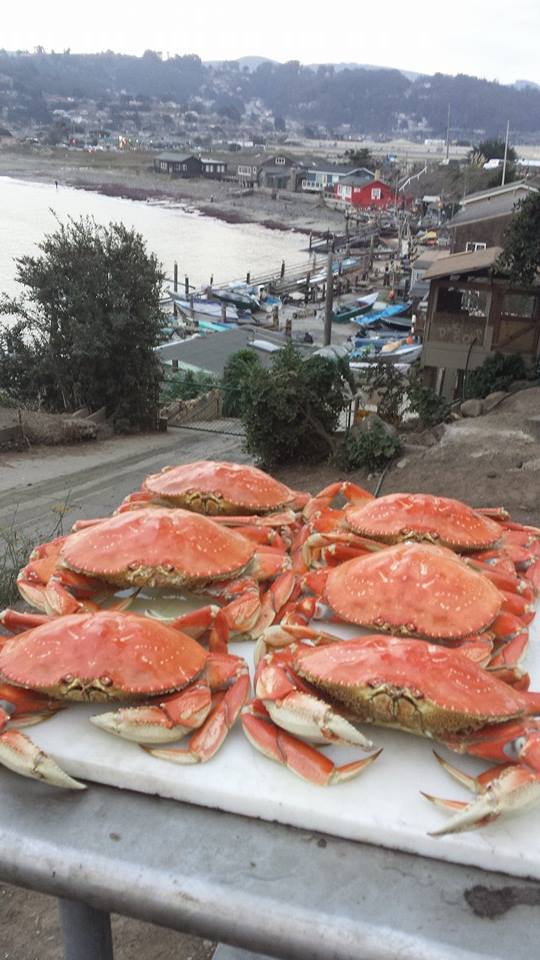
Crustaceans
While the pier today rarely sees the impressive number of fish seen in earlier years, it does yield good numbers of Dungeness crab. In fact, more Dungeness are caught at this pier than any other pier in the state. In part, this reflects the fact that it is illegal to keep Dungeness crabs caught from piers in San Francisco Bay. Rock crabs are just fine but Dungeness crabs are a no, no since the Bay is considered a nursery area for Dungeness.
But, it is perfectly legal to keep Dungeness at this oceanfront pier and the pier is often jammed with crabbers seeking out the delicious crabs during the November-June Dungeness crab season—at least when the weather, tides and currents cooperate. Photo at left by Glen Hogerton
Of course the trio do not always cooperate. Pacifica is famous for strong winds and heavy, pounding waves. One PFIC report, in November 2007 said there were 15’ waves at Pacifica and that the crabbers had gone home (although a few misguided surfers were still in the water). The next day saw huge 27-foot waves crashing over the pier and both crabbing and surfing was called off. Terra firma was just a little bit safer than the concrete pier. Big waves and crabbing do not mix.
Still, good weather and tides do not guarantee good crabbing at Pacifica. It simply means Pacifica sees more crabbers than any other pier and a sufficient number of crabs are caught to keep the people coming back.
Rock crabs are also found at the pier, and can be kept year round, but Dungeness are the special crabs prized by most (although some prefer the slightly sweeter meat of the rock crabs). Crabbing does seem to have become more and more popular and at times, when the crabbers are out in force, fishing for actual fish is almost non-existent.
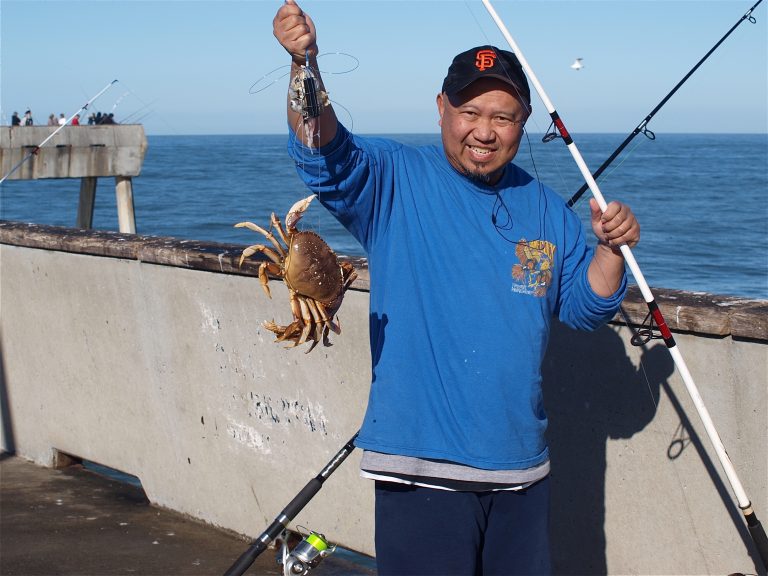
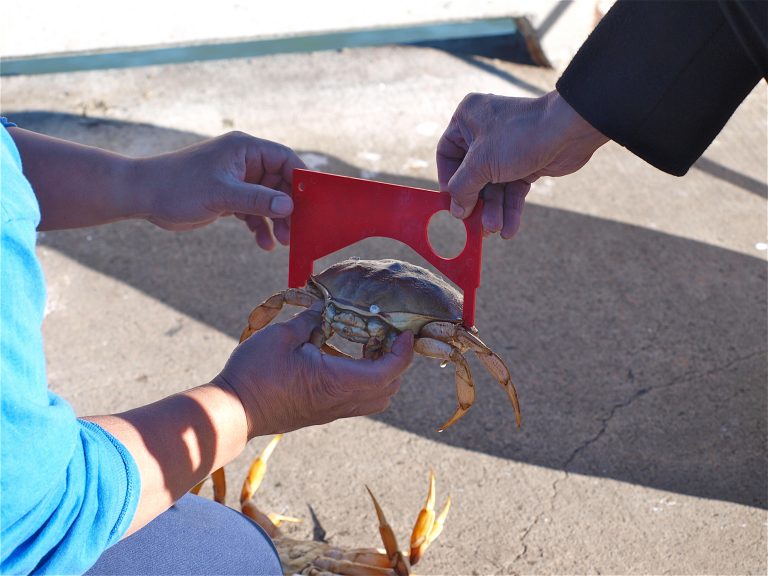
Fishing Tips
As at most piers, the key is deciding the type of fish you want to catch. Once you decide that the other key questions can be answered: what area to fish, what tackle to use, and what bait or lures to use? The only question that remains will be if you can find a spot on the railing.
As for myself, when I fish Pacifica I like to try for variety—some small fish quantity and some bigger fish quality. With that in mind I usually use two rods and several types of bait and riggings. One rod will be fairly light and rigged for perch; the second will be a medium action rod/reel that can be used for something a little bigger.
Perch —I have taken eight different kinds of perch at the pier and they fall into three general groups. The first group, and my favorite, is the large surfperch (redtail, calico and barred) that are found in the first third of the pier, from the breakers to about halfway out on the main stem of the pier. For all three species a high/low leader with two hooks above the sinker on short dropper leaders works best. I like to use torpedo sinkers but if the current is strong use a pyramid or triangle-type sinker that will grab the sand on the bottom. Hooks should be size 6 or 4 baitholder hooks. Use live sand crabs (if you can find them), pile worms, fresh mussels, or small pieces of shrimp or clams as bait.
I like to cast out and then retrieve SLOWLY. I do not simply sit the rod on the railing nor let the bait sit stationary in the water; fish like moving bait. Cast and retrieve, cast and retrieve, cast and retrieve. Yes, it is bait but you almost want to use it like a lure. The main problem here can be crowds and if the water is heavily covered with lines it may restrict the cast and retrieve program.
All three species may be found year round but he winter months are the best for the large surfperch. 79% of the redtail surfperch, 91% of the barred surfperch, and 67% of the calico surfperch I have taken from the pier have been caught December-February even though only 31% of my trips to the pier were during those months.
The second group of perch is the smaller schooling surfperch. Walleye, silver and spotfin surfperch provide most of this action. Although most anglers like to fish for these with bait rigs, usually Sabiki rigs, I prefer a high/low rigging with a torpedo sinker at the bottom. However I switch to size 8 or 6 baitholder hooks. Small pieces of bait finish the presentation.
The walleye seem to prefer small strips of anchovy but will also hit on pile worms or small pieces of market shrimp. The silver and spotfin seem to prefer the worm or shrimp but will also hit the anchovy. Go figure.
These perch tend to be found in the mid-level area of the water and what I do is drop the rig to the bottom and then move the bait up a couple of feet at a time. When I begin to feel bites, that’s the area I fish. Sometimes schools of walleye seem to be under schools of silvers and spotfins (but often they are mixed).
But, to be honest, some people refuse to use anything but bait rigs; they swear by them, I swear at them. They work and are easy to use. You can use a commercial six-hook bait rig like a Sabiki or Lucky Lura, or make your own leader with three or more size 8 (or smaller) hooks tied directly onto the line. Given the amount of $2-4 Sabikis seen tangled in the pilings or hanging from the pier, I would suggest making your own.
Most of the time when using a bait rig you do not need any bait on your hooks, a simple up and down jigging motion will hook the fish. However, if you sweeten a couple of the hooks with a small piece of bait, more fish may be attracted to your line. Sometimes though you need bait with the above-mentioned bait being best and, as with the high/low rig, simply drop the line to the bottom and slowly reel to the top until you find the fish.
When using pile worms or shrimp, you may also find yourself catching Pacific butterfish aka pompano. They are a small fish considered to be delicious eating. However, most are so small they seem to deserve being released.
The third group of perch is the seaperch—striped, rainbow, rubberlip, black, white and sharpnose. The first four typically are found down around the base of the pilings. Bait and tackle is similar to the first grouping of large perch (high/low, size 6 or 4 hooks, and a small torpedo sinker). Fishing for them requires care since you want to keep the rig near the mussel-covered pilings without getting snagged on the pilings. I always give it a try just to see if any of the seaperch are around but usually move on to the search for other species at some point.
White seaperch are encountered on the bottom areas away from the pier. Most are an incidental catch by those fishing “for anything” on high/low rigs baited with pile worms or pieces of shrimp.
Sharpnose seaperch are sort of an in-between species of perch sometimes caught on the bottom and sometimes caught mid-depth. A high/low rig with size 8 or 6 hooks baited with pile worms or small pieces of shrimp offer the best chance for the elusive perch that are only caught at a few piers (most in Monterey Bay).
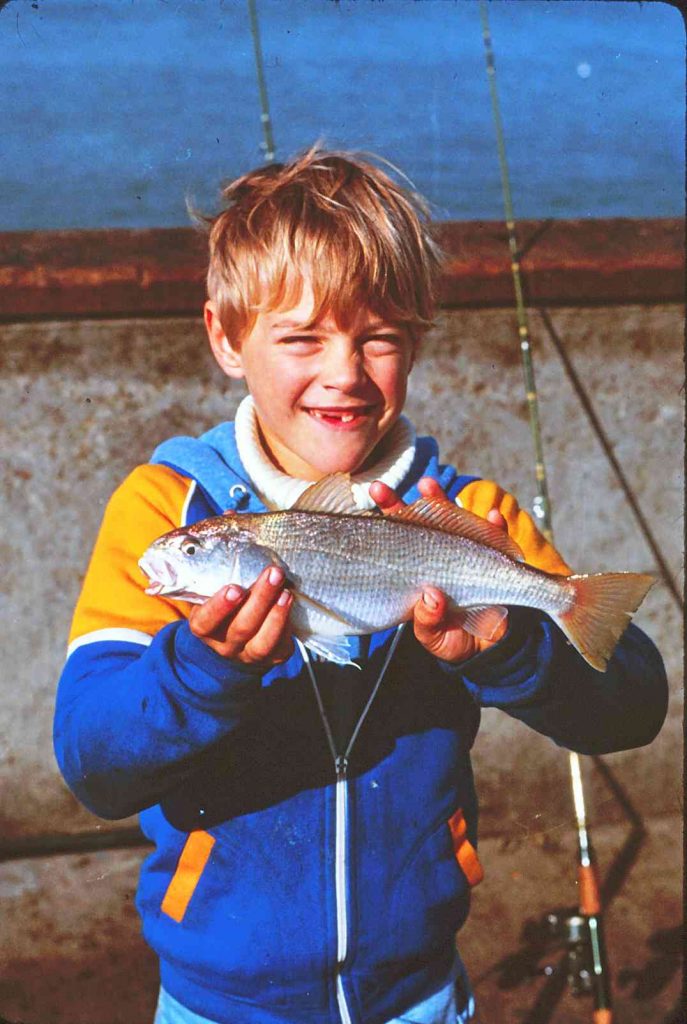
Miscellaneous Bottom fish — Kingfish (white croaker) are the main fish landed and they are landed year round. Best rigging is a high/low rigging with size 6-4 hooks. Best bait is a small strip of piece of anchovy or mackerel, a piece of pile worm, or a strip of squid. The kingfish will often hit on the drop. Cast out, let the bait sink to the bottom, and immediately tighten the line. Often you will feel a hit as soon as the line in taunt. Strike and if the strike is missed start to slowly retrieve the line. The kingfish will often follow the bait all the way to the pier and, in fact, will often hit the bait as it begins the upward trajectory to the pier. They aren’t much in the way of “fighter class” fish but provide some action when the more sporting fish are missing in action. Left is Ken Jone’s son, Mike, holding a Kingfish (white croaker).
Everything said on the kingfish can be applied to Pacific tomcod with the exception of numbers. They are a schooling species and if the school decides to visit the pier’s waters they will be caught. But when will they visit the pier? It’s hard to say since I have caught them sporadically throughout the year with no discernible pattern.
Staghorn sculpin are another year-round species and can be caught in almost the same fashion as the kingfish (although they just as soon will hit a bait resting peacefully on the bottom). If they are around, they will find your bait. Some people will switch to somewhat bigger bait when they are present but that doesn’t seem to stop them, I’ve seen the small sculpin grab baits that would barely fit in their mouths.
As for the rocky-shore species—lingcod, cabezon, greenling and rockfish; all will be caught around the pilings and the best rigging appears to be a high/low rig outfitted with size 4 or 2 hooks. Bait up with pile worms, fresh mussels, or pieces of shrimp, and fish close to the pilings on the bottom. Be careful! You must hold your rod at all times and “feel” where the bait is sitting (or being swept). You will probably still lose a rig or two but one of these nice fish is worth the effort if you can catch a legal-size fish.
Mid-water and Top-water Schooling Species — Jacksmelt can show up almost any month and since they are usually in large schools if you catch one you will probably catch more. Most will be caught on bait rigs but I prefer to use my two-hook high/low rigging. They are a hard-fighting fish and one or two on a line are much more fin to catch than a half dozen fighting almost against one another.
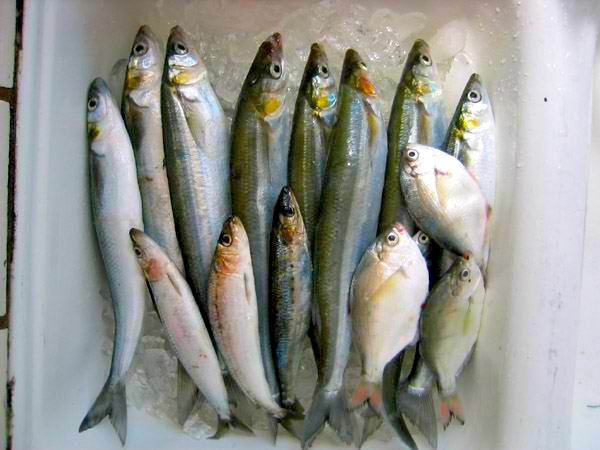
Jacksmelt and Perch
Jacksmelt are a mid-water species, often 4-6 feet below the surface, so anglers using Sabiki-type bait rigs will employ a variety of devices to keep their baits near the surface. Some use balloons (a bad idea for the environment), some use big bobbers, some use a piece of Styrofoam and all will work. Generally, the big smelt (to around 14-15 inches) prefer a piece of pile worm for bait although at times they will hit nothing but pieces of shrimp, strips of squid, or pieces of anchovy/mackerel. They can be finicky at times; at other times it is wide open anything goes..
Some years may also see Pacific mackerel and/or Spanish mackerel (mackerel jack). If they are present the same rigs and same baits will work as for jacksmelt. One thing to note is that a Sabiki rig filled with a whirling dervish mix of four-six mackerel often means a complete mess and a loss of the tangled leader. It’s one reason I stick to my two-hook high/low rig, which also seems more sporting. Plus, why do you need to catch a half dozen mackerel at a time? Are you really going to eat that bucket full of fish?
Pacific sardines are a fish that showed increasing numbers in the ‘90s and diminishing numbers after about 2008. However, they seem to be increasing again and if/when they show at the pier they can be caught in huge numbers, 4-6 at a time, with unbaited bait rigs. Simply cast out the Sabiki or Lucky Lura utilizing a torpedo sinker heavy enough to cast through the wind, let the rig sink midway to the bottom and begin a retrieve. Sometimes a fast retrieve is needed, sometimes a herky-jerky retrieve is better (it seems to vary) but once you get the technique you should catch fish. They are good eating and they make great bait.
If the sardines show up during the striper season (spring to fall), knowledgeable anglers will put a live sardine on a trolley line rig near the surfline. Oftentimes a striper will be the result.
Everything said about the sardine can be applied to Pacific herring although the herring will generally make a wintertime visit if they decide to make a stop at Pacifica on their way to San Francisco Bay. As such they aren’t utilized for live bait unless an angler is really hopeful. But, they still are good eating and good frozen bait.
Northern anchovy also make great bait and sometimes seem to cover the pier’s waters. When present, bait rigs can be employed but use a smaller-size hook than that used for the larger fish. Typically a steady retrieve is all that is needed to hook the small bait fish. Pizza anyone?
Do be cautious. One trip saw me jigging with a Lucky Lura leader for some live bait (to use on my heavier salmon rig). Unfortunately, the water was thick with smolts (baby salmon) about the size of herring. After hooking and releasing about a dozen of the small fish, I decided to call it quits with the leader. Unfortunately not all the anglers that day looked at things the same way and too many of the small fish were kept and killed. These small, illegal fish need to be left alone by anglers. Enough of these fish will be eaten by other predators before reaching adult size so don’t complicate their lives any more than necessary.
Flatfish—Four main flatfish are caught and each require different rigging.
Two sanddab species show at the pier, speckled sanddab and Pacific sanddab. The speckled are a small species too small to keep as food and never, at least to my satisfaction, proven to be decent bait. The speckled sanddab are an incidental fish caught year round and showing up unexpectedly whenever a small hook baited with food is left on the ocean floor.
Pacific sanddab are larger (although not big) and provide good table fare if enough are caught — and that’s rarely a problem. The fish are a schooling species and when present are caught in large numbers. Use a two-hook high/low with size 6 or 4 hooks and you’ll probably get two fish. Use a six-hook bait rig and you might get six fish.
Cast out the line, let it sit on the bottom until you start to feel the nibblings of the ‘dabs and then begin a slow retrieve. Whatever hooks are still empty may be grabbed by a fish. Baits vary but I’ve had the best results using pile worms. But when they are hungry they will hit almost anything—pieces of anchovy, small pieces of shrimp, or small strips of squid.
Unfortunately they do not make a showing ever year and when they do show they usually only make a short December-January appearance. In addition, my records show that almost all of my sanddab catch at the pier was made early in the morning, right at daybreak and all the fish were caught out at the end. Anglers fishing mid-pier caught few if any sanddab and those coming later in the day never saw a single sanddab.
Sand sole are an interesting mid-sized flatfish that is both attractive and good eating. Luckily for Pacifica anglers, the pier is probably the best in the state for the sole. They are most commonly caught in the mid-pier area and can be encountered in almost any month of the year (although summertime, especially June and July, is the peak season for the fish). The largest I have caught at the pier was a 19 3/4-inch sand sole caught during my first visit to the pier in September 1975.
As to rigging and bait, I’ve caught them on both high/low rigging’s and on a sliding live bait leader. Best baits include pile worms, cut bait—anchovy, sardine or even squid, and shrimp. Unfortunately, many anglers do not recognize sand sole for what they are, they think they are halibut, and release the fish as under-sized. Know your fish!
Fishing the same area may also attract another mid-sized flatfish — starry flounder. They’ve been reported to 12 pounds at the pier although the largest I’ve caught was a July ’78 fish measuring 17 3/4-inches.
Best luck for these is with (a) one of the traditional Bay Area sliding live bait leaders (plastic that attaches to a sinker while the line goes through the plastic) or (b) a Carolina-type live bait leader (line through a hollow egg sinker before attachment to a swivel and then a 2-3 foot leader. attached to. Live bait, a small smelt or small perch works well as does pile worm and cut bait—anchovy, sardine, squid, etc.
California halibut are the prize flatfish at the pier. They’re primarily caught from May until September and fish to 32 pounds have been landed. They’re found mid-pier out to the end (although it’s hard to fish for them at the end if a salmon run is on).
Almost all halibut are caught on live bait — anchovies, small smelt, small perch, or sardines, and some type of live bait leader is used. The plastic Bay Area variety works as well as the Carolina rigging although some people try the same sliding “trolley” leader used for salmon. Although artificial lures are one of the most efficient ways to land halibut in SoCal, and “trolling the pier” in the depressions between the pilings might produce fish, the sheer number of anglers, combined with the vicious tides and current sometimes found at the pier, make artificial lures an “iffy” proposition.
If fishing for the halibut make sure to use at least 20-pound test line and be sure to have a hoop net to bring the halibut up to the pier.
Big Skate – 1998
Sharks and rays—As mentioned, the pier is not noted for sharks or rays. Nevertheless some sharks are caught, mostly leopard sharks or brown smoothhounds. In addition, a few “shark anglers” still give thresher sharks a try if the pier isn’t too crowded.
Leopards and smoothhounds are common from almost the tideline to the end but most are hooked in the mid-pier area. They can be hooked on high/low rigs as well as Carolina-type rigs. If using a Carolina rig try baiting up with a small perch—walleyes, silvers and spotfins, or sardines (if they are running). For high/low rigging’s use cut bait—anchovies, sardines, mackerel or squid.
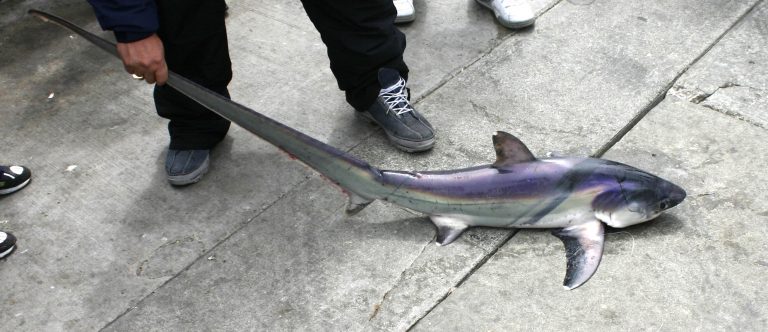
Thresher Sharks
Thresher sharks are the favorite of anglers and threshers to 10-feet in length have been recorded (although much of that was the long tail). For those seeking out the large sharks the equipment is usually a fairly heavy 9-12 foot rod, a large reel equipped with 50-100 pound line, and a sliding live bait leader. A 5-7 ounce sinker is cast out as far as possible and then the sliding leader is snapped onto the line before sliding the leader down the line. The leader is fairly long with a float of some type (big bobber or Styrofoam) located mid-way down the leader to keep the rig near the surface. Another 6-8 feet of leader is under the float terminating in a large hook and lively bait. Treble hooks are favored by many anglers since threshers will often swat the bait with its tail before biting it bit some anglers simply use a large hook.
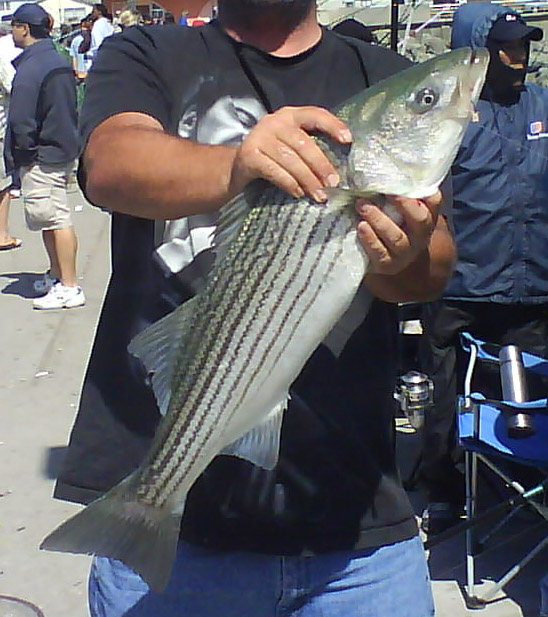
Striped Bass
Striped bass are one of the two prized fish at the pier and, unlike salmon, seem to be taken in fair to good numbers every year. It shouldn’t be surprising given the fame that local waters held for stripers for so many years.
The bible on stripers says they leave the inland streams, move through the Delta, and pass through San Pablo and San Francisco into the Golden Gate and Pacific waters every spring. In the fall they reverse that trek. Thus the normal June to October striped bass season makes logical sense (even if many locals consider July 4 as the kickoff date for Mr. Linesides). When they start to be caught the season is on!
Most are caught on the inner third of the pier, often right in or next to the surf with both bait fishermen and those casting artificial lures welcome (if the pier isn’t too crowded).
Although techniques change over the years, a high/low leader baited with pile worm, ghost shrimp, or whole or cut bait—sardine, anchovy or small perch, is still often the best bait. An alternative is a live bait and usually today that means employing a Carolina-rig with whatever live bait can be procured—shinerperch, small surfperch, small smelt or, if they are running, a sardine (although a pile worm can also be used with the rig).
Use a hook size 2 to 4/0, heavier line (at least 20-pound test), and be sure to have a way to bring the fish up onto the pier since stripers to at least 43 pounds (maybe bigger) have been caught off the pier.
Another approach is to use an artificial lure, most likely a plug or spoon, fish an area away from other anglers (if you can find such a spot) and cast just outside or even into the surf line. During the low tide, check out the inshore area and look for depressions along the surf, these are the places to try first. Unfortunately, it is harder for a pier fisherman to use these lures than an angler fishing from the beach (although Mickey Jigs and Pencil Poppers tend to compensate for heavy wind conditions). If conditions permit (somewhat light winds), you can try lighter spoons and jigs. Krocodile spoons (chrome with a lime-green strip,) or Hopkins jigs, are the choice of many surfcasting “experts.”
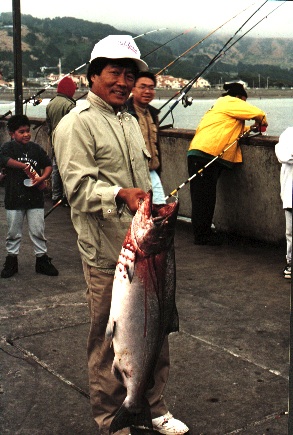
Salmon – Photo left is of a King Salmon 1998
King salmon are, of course, what made the pier famous and at least a few are usually present most years. If they show up the season can run from June until October or November (although late June to late July is generally the peak time). Hundreds of bobbers/floats will dot the surface of the water when a “run” is on, ranging from the surf area to the end of the pier. The best spots, when you can get them, are at the far end, both the left corner, and the end area that runs to the right corner (an area affectionately known as “Little Manila” or “Manila Town” and populated by the regulars—“The Filipino Mafia.”
Most of the salmon are caught by the regulars using the famous Pacifica trolley rigs, modified sliding “trolley” leaders. A heavy saltwater rod and reel, spinning or conventional, equipped with 30-50 pound line is used. At the end of the line a 5-8 ounce spider or sputnik-type weight is attached, size depending upon the current. These weights have four spikes on one end that are set into position by pulling the line in a low position after the cast; if done correctly the spikes will be wedged into the sand.
The trolley leader is then slid down the line via a strong snap swivel. The leader itself has a float (usually a large 3-4“ Styrofoam bobber set a couple of feet under the swivel to keep the leader near the top of the water. Some anglers will then attach a reflector (flasher) of some type to attract fish but they’re rarely needed. The leader extends another 10-20 feet or so under the bobber depending upon the tide and the depth at which the salmon are feeding. The leader terminates in a hook and bait. The hook should be a barbless circle hook, the legally required hook for salmon in California (although many ignore the rule). Typically the bait is a “popsicle’—a frozen anchovy that has been threaded onto the leader by the use of a bait thread needle.
You’ve set out your bait and are waiting for a fish. What’s next or what’s the best approach. A PFIC regular gave some clues: Posted by Calrat, June 30, 2004 — When a salmon bites on the classic Pacifica Trolley rig, I set my drag loose to a point where it can run but not too far. The bobber can go down but usually what happens is you’ll see it flying off into some direction. (That’s if you’re watching the bobber) You’ll also notice your rod jerking around… There are so many people out there, when a fish is on, usually the regulars will just start yelling a color of the bobber going this way and that way. As aggressive an environment as it may seem, the Pacifica Pier fishermen help each other out by keeping an eye out on everybody else’s line. If you plan to go out this weekend, AND I THINK YOU’RE NUTS, then good luck. You shouldn’t have any problems knowing if a fish is on… If you’re an honest fisherman, and I hope you are, you’ll be using a circle hook with no barbs (as per the guidelines of the DFG). The fish will take your bait and set itself. MAKE SURE YOU DON’T GIVE ANY SLACK EVER DURING THE FIGHT WHEN USING THE CIRCLE HOOK OR IT WILL COME OFF! If you’re a crooked fisherman, and you’re using a regular hook with barbs, set it when the fish is on even though it’s probably set already… that is, just to make sure you have him on good. It’s much like a small bat ray fight
Sometimes the salmon come in closer to shore and the anglers mid-pier will use a shortened trolley rig. If baitfish is present, they’re usually being caught and that’s when the anglers will switch to live bait: a live anchovy or sardine instead of a “popsicle.”
A necessary piece of equipment is a hoop net to bring the large fish up onto the pier. Although most Pacifica salmon will weigh 6-12 pounds, fish over 20 pounds are common, and 30 pounders are seen fairly often. The record appears to be a 51-pound monster that was caught the last week of July 2002.
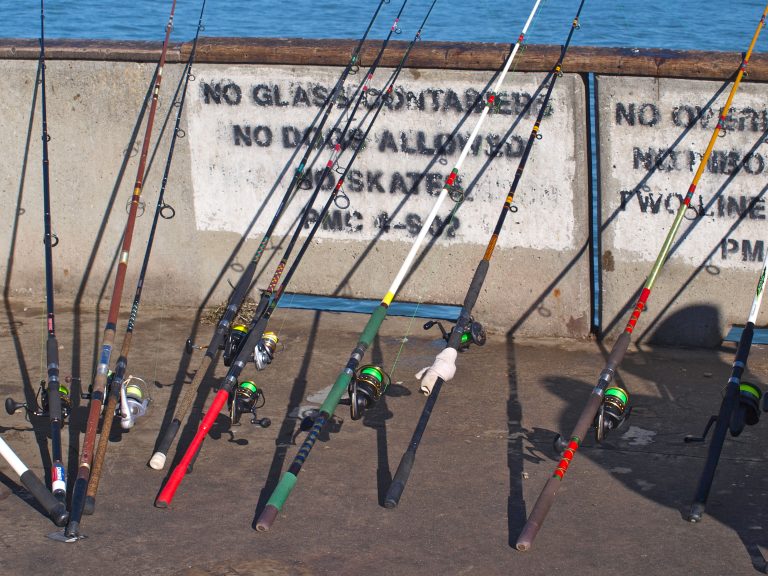
What probably should be considered an essential piece of equipment are the dual purpose special “Pacifica rod holders” available at local bait shops (and sometimes from people on the pier). It’s a welded rod-holder specifically made to fit the pier’s railing. Dual purpose? To hold the rod and to claim the territory.
Do make sure you know what you are doing if you decide to join the fray when the salmon “are in.” The fishing is serious business to the throngs who invade the pier during the salmon invasion and fools are not suffered lightly.
Using improper sinkers that don’t hold bottom (resulting in tangled lines), failure to get out of the way of a hooked fish, or barging into someone’s space can result in things like cut lines and threats. It’s elbow-to-elbow fishing that the more caustic liken to a “combat zone” and be alert if you hear someone yelling “headache” while making an illegal overhead cast.
Read up, ask questions, bring the right equipment, and know what to do when you head out to the pier. You can usually also get some advice from the locals but it will depend upon your already existing knowledge, your willingness to listen, and a little bit of common sense.
In all the years I fished Pacifica I never had a problem but Î have heard stories of some that have. By the way, an early arrival is always good. Depending upon the tide there may only be a small contingent of anglers when you arrive, thus assuring yourself of a good spot. As high tide approaches the numbers start to increase and sometimes they can jump up to 200-300 people. Soon there’s a crowded railing (and three inches of railing space next to you can be considered a free spot). But, it’s probably better for them to barge into your space than for you to barge into their space (not fair but better).
One problem that has increased over the years is sea lions, when the salmon show up the sea dogs will not be far behind. Some days may see as many as a third of the salmon ambushed before they reach the nets that have been lowered into the water.
Crabbing Tips
Two types of tackle are used by those seeking out the tasty crustaceans on the pier, the normal old-fashioned crab (hoop) nets and the increasingly more common crab snares. Crabbers seem divided as to what to use and each has its pluses and minuses.
The main plus for crab nets is that they don’t require much additional equipment other than the crab nets and goodies that come with them (rope and bait box). There are a couple of negatives for their use at Pacifica: (a) Though they work well during mild conditions the gigantic waves at Pacifica can render the nets almost useless at times and make it hard to keep the nets away from the pilings. Many hoop nets are lost to snags and the loss is costly. (b) Sea lions have learned to search out food in the hoop nets and reports of tug-of-war contest between crabbers and sea dogs are common. Usually the sea lion wins.
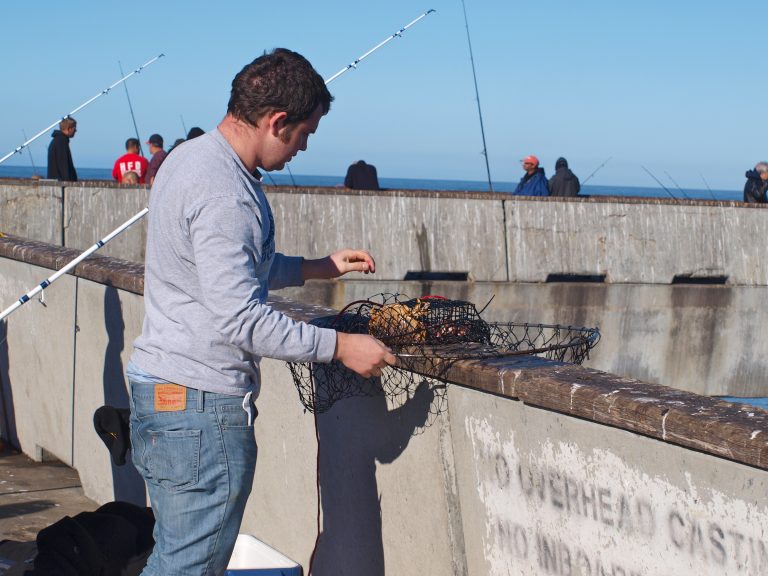
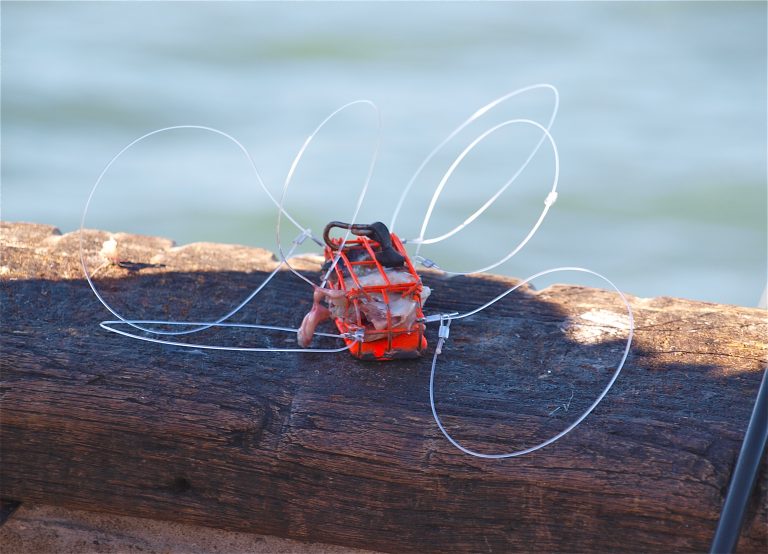
The pluses for crab snares are that they have proven to be effective and they reduce the chance of losing gear. In addition, fairly inexpensive snares can be purchased at local bait shops. In addition, a few entrepreneurial souls make and sell their own snares on the pier (at an even less expensive price). Those people are on the piers most weekends and at least one includes a sinker and a shock-leader with his snares. But snares too have negatives, the main being the need to have an additional item —a fairly heavy rod and a strong saltwater reel to cast out the snare along with sufficient line (30 pound plus).
How do you tell when a crab hits a snare? PFIC regular dsmiths supplies an answer: “It seems to be typically a long, slow pull followed by a quick sometimes jerky release. You can tell the difference between this and wave action because the waves will move slowly in both directions.”
The best bait for both hoop net and crab snare, as always, is squid with sardine, squid with anchovy, and squid with mackerel. The fish supply the oily and/or bloody scent while the squid are tough and survive attack. Use chicken and your gear may be pulled apart by sea lions. Why the pinnipeds favor chicken over fish, no one seems to know but fewer are using it (even though it was once considered the “bait de jour.”
Whatever the tackle it’s common most days to take at least a few keeper-size crabs from Pacifica and some days will yield limits of the tasty crustaceans.
Just like their cousin “lobster poachers” to the south, “Dungee poachers” can also be a problem at the pier. They like to show up at night armed with multiple snares and a proclivity to keep Dungeness that are out of season, as well as crabs that are too small.
Fish and crabs at Pacifica, an interesting overlook with some interesting observations, some good and some not so good. But, as one angler mentioned to me, what other California pier allows you a chance to catch both salmon and crabs on the same day, a veritable potpourri of gastronomic delicacies. Makes you kind of want to take along a tablecloth, a bottle of white wine, and some sourdough bread. Of course, I’m not too sure where you would stage this Epicurean feast; when fishing is good the pier can be crowded, dirty and, in blunt terms, smelly. Dried blood, bullhead slime, sun-ripened bait, angler urine and seagull droppings do not exactly lend the proper ambiance for a picnic. I once suggested to my daughter that her wedding would be fairly unique if it took place alfresco, out at the end of the Pacifica Pier. She said, in no uncertain terms, NO THANK YOU and gave me that stare. That was the end of that conversation.
MORE ON THE PACIFICA PIER:
Below content is past informational history – see notes for current information
Fish surveys done by the California Department of Fish and Game for the years 2004-2009 show a mix of 27 species of fish at the pier. The species (listed numerically) — white croaker, shiner perch, walleye surfperch, jacksmelt, silver surfperch, northern anchovy, Pacific sanddab, white seaperch, striped seaperch, Pacific sardine, barred surfperch, sharpnose seaperch, Pacific tomcod, Chinook (king) salmon, kelp greenling, striped bass, spotfin surfperch, rainbow seaperch, pileperch, calico surfperch, redtail surfperch, black perch, rainbow trout (steelhead), starry flounder, sand sole, brown rockfish and leopard shark.
The numbers, as expected, are dominated by the schooling species—perch (shiner, walleye, silver, white, striped and barred), top-water species—jacksmelt and northern anchovy, and two bottom species—white croaker and Pacific sanddab. Striped bass were recorded five out of the six years while the king salmon were counted only one year, 2004. Surprising to me were the fairly high number of striped seaperch (recorded four years) and sharpnose seaperch (recorded two years). Very surprising to me was the low number of calico and redtail surfperch that were recorded (both only recorded for one year) and the absence of any staghorn sculpin (that have always been among the most common fish at the pier). It’s simply hard to explain some of the numbers
Pacifica Pier Vandalism — The vandals who pried up concrete benches from the Pacifica Pier and possibly tossed them over the side into the ocean cost the city nearly $6,000. That’s the estimated cost to replace the benches, which were discovered missing July 20. The culprits also pried up a steel plate from the floor of the pier. (Police Beat, Pacifica Tribune, August 1, 2007)
Fact: Most piers seem to appear in a movie sooner or later. The Pacific Pier was seen in the 2003 film “House of Sand and Fog.”
Although the following fish wasn’t caught by hook or line it was found by the pier and could have been caught—right?
In the category of the weird, slimy and mysterious, a denizen of the deep washed up — still writhing, mind you — on the beach near the pier. The fish, which was over four-feet long, was identified as a longnose lancetfish, which the Peterson field guide describes as a toothy (named for its lancet-like teeth) scaleless, voracious deep-water predator with a dorsal fin like a sailfish who also happens to be a hermaphrodite. The fate of the critter, who occasionally washes up on beaches for no apparent reason? A picture was hastily taken before it found its way into a crab net to be used as bait. So much for science. (Brian Hoffman, The Fishing Report, San Francisco Chronicle, June 13, 1996)
A short distance down the shoreline from the pier is Laguna Salada, a freshwater lagoon and marsh area fed by Sanchez Creek, a creek that serves as a tributary of the larger San Pedro Creek.
Records show that the water in the creeks was once home to steelhead and silver salmon. A 1912 letter indicates San Pedro Creek was stocked and over the years it was noted that steelhead spawned in the creek. In 1968 the California Department of Fish and Game reported there were about 100 steelhead in San Pedro Creek and that the steelhead resource was both viable and important. However, it also reported that continued sedimentation, the construction of culverts, water diversion, and urbanization was affecting spawning habitat and leaving “the long-term survival of the steelhead resources in question.”
Urbanization of Laguna Salada itself dates in large part to 1931 when the City of San Francisco built the Sharp Park Golf Course golf course over the wetlands (and eventually a seawall was built to protect the area). This has led to considerable debate and lawsuits. The lagoon area is home to two endangered species—the California Red-Legged Frog and the San Francisco Garter Snake, and a “Save The Sharp Park Wetlands!” movement emerged. People want the area restored, want the seawall removed, want the golf course removed, and would like to have the land turned over to the National Park Service to become part of the Golden Gate National Recreation Area. To date, San Francisco has refused. It’s unclear if the steps mentioned would result in a return of the steelhead and silver salmon.
History Note – The Rev. Herschell Harkins Memorial Pier a.k.a. the Pacifica Pier (“Dedicated to a fisher of men”) was built in 1973 and designed in part to serve as a support structure for sewage pipes that stretch from the shoreline out a short distance past the pier. Almost immediately after opening, the pier began to attract a devoted legion of anglers (including myself).
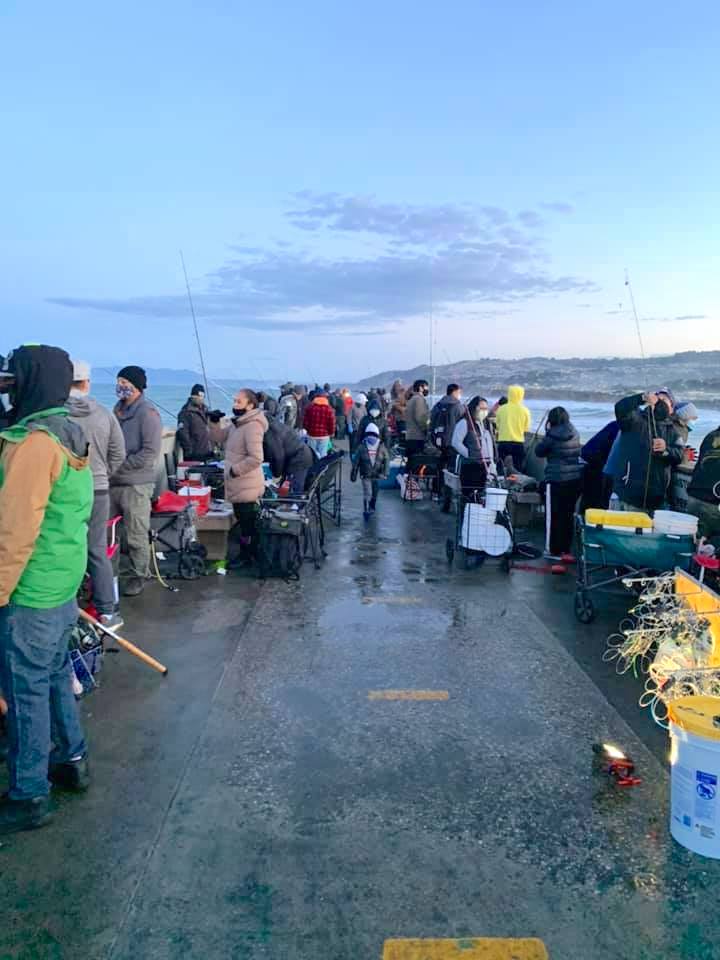
(Photo left by Tony Pena) – Pacifica’s future as an ocean fishing center for the Bay Area seemed assured this week as opening of its 1,060-foot Sharp Park fishing pier continued to draw daily crowds of fishermen — of all ages.
Winners of the first annual fishing derby to be held at the pier was announced by Recreation Division Administrative Assistant Walter Kohnert. Some 300 persons entered the derby Saturday while another 700 just strolled around the pier, during the intermittent rainfall. The pier was not over-crowded.
Biggest fish caught was a four-pound leopard shark, reeled in by Dennis Niebuhr, followed by a 41-ounce flounder, caught by Hillard Sims. The two men won first and second place trophies in the adult division. Other winners were: Junior Division (6-9 years old): First, Rene LaForge, 13-ounce perch; second, David Navarro, 8-ounce smelt. Junior Teen Division (10-13 years): First, Eric Lindstrom, 20-ounce skate; second, Pete McGrath, 18-ounce perch. Teen Division (14-19 years): First, Mike Kent, 18-ounce catfish; second, Steve Bode, 17-ounce perch…
After a malfunction opening day, the lights for the concrete pier have been burning day and night, despite protests to City Hall over energy waste. Lights will be turned off during days when city workers are satisfied that they are working all right.
Some $20,000 worth of vandalism was inflicted on opening day, under cover of darkness, but City Mgr. Dave Thompson believes that the combination of lights and police checks will reduce vandalism.
The pier thus offers (*1) 24-hour a day fishing. It includes benches, strollers, and fish-cleaning tables. A bait and (*2) refreshment shop, at the foot of the pier, will be open on Dec.1.
(*3) Elmo J. De Deaux, who will operate the shop, advises that the most common kind of fish to be found will be jack smelt, perch, kingfish (croaker), cabezon, flounder, halibut, shark, eels, crabs, and California skate (small stingrays). In addition, from June to October, striped bass and salmon can be found.
—San Mateo Times, November 16, 1973
In the winter of (*4) 1992 engineers warned that the sheet pile bulkhead supporting the first span was corroded. The city quickly closed the pier—and then reopened it a week later. Meetings were held, letters streamed in from throughout the United States, and the mayor and council debated what should be done. Eventually it was closed again. In July, just in time for the main summer fishing season, the pier was reopened after a five-month closure; anglers quickly began to catch salmon, kingfish, perch, jacksmelt, sanddabs and some mackerel. Although most people agreed that it was safe enough to open, all agreed it still needed additional repairs. The repairs were finally started that October and the pier was declared “fixed” a few months later. However, major problems still exist.
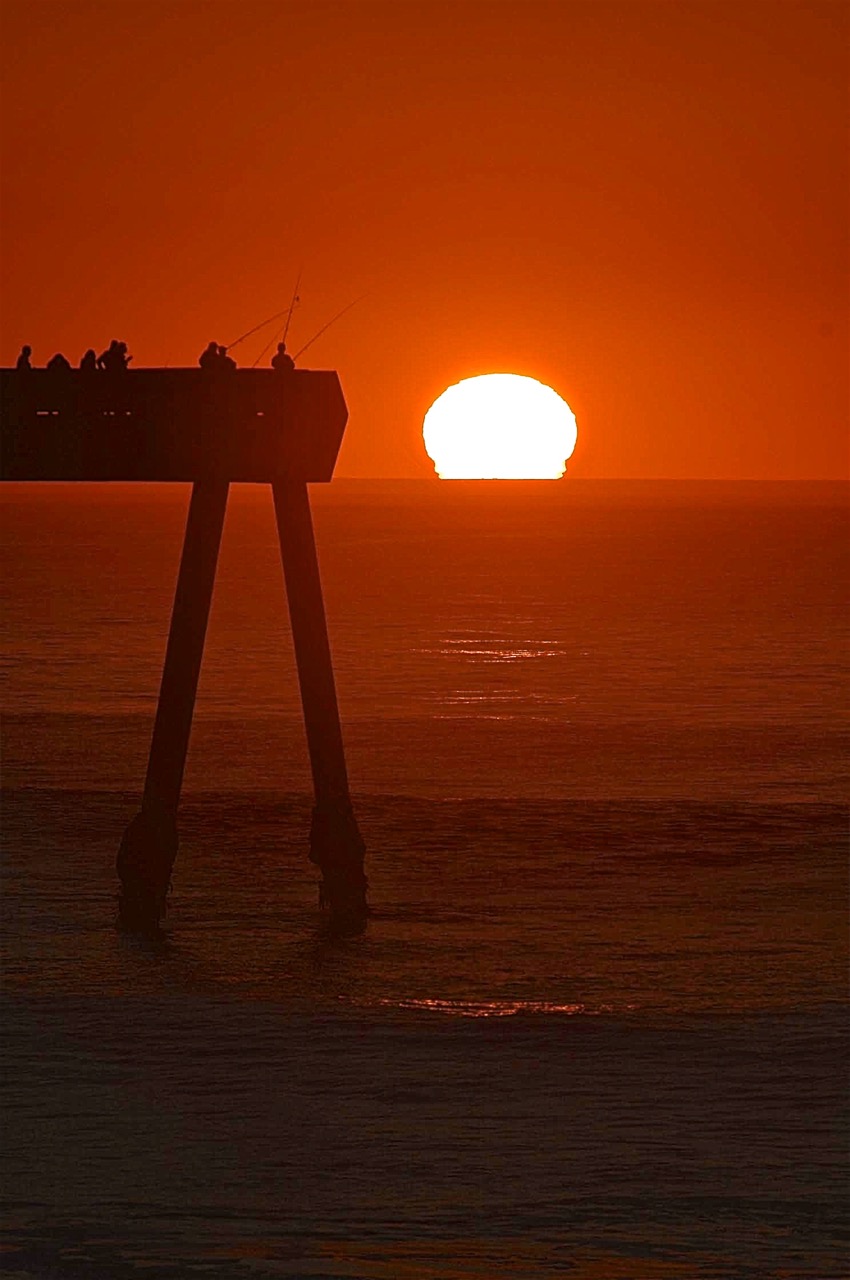
(Photo left by Glen Hogerton)
Hours: Daily – 4 A.M. to 10 P.M.
Facilities: The pier has lights, fish cleaning stations, some benches, restrooms at the base of the pier, and a bait shop/snack bar at the front of the pier. There is free parking on adjacent streets; although not enough when the salmon are “running.”
Handicapped Facilities: Handicapped parking. The surface of the pier is concrete with a ramp leading to the south side of the pier. The concrete siding on the pier is approximately 40 inches high and provides safety for both children and wheelchairs.
How To Get There: Take Highway 1 south to Pacifica. Take the Paloma Ave. -Francisco Blvd. exit. Take Paloma Ave. west to Beach Blvd,, turn left and follow the coastal road to the pier, 2100 Beach Blvd.
Management: City of Pacifica – For up to date information please visit: https://www.cityofpacifica.org/depts/pw/parks/pacifica_pier.asp
Notes:
*1 – Pier operation is daily from 4am to 10pm
*2 – Refreshment shop is now the Chit Chat Cafe open daily from 7:30am to 5:30pm
*3 – Bait shop at the end of the pier is the Chit Chat Cafe & carries some bait. The bait and tackle shop is now called Good Luck Live Bait and Tackle, (previously Coastside Bait & Tackle), at 1604 Francisco Blvd. and is under new ownership.
*4 – The “L” shaped western end of the pier is currently closed due to permanent damage. The City of Pacifica is currently analyzing to resolve the issue. Press Release March 30, 2021: Click Here
The original blog post can be viewed by Clicking Here
Special thanks to Ken Jones – Please visit his website by Clicking Here
For more about Ken Jones Click Here
All photos courtesy of Ken Jones except where indicated.
